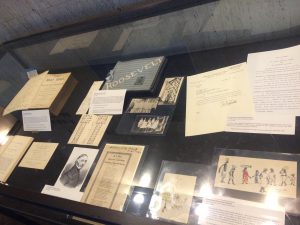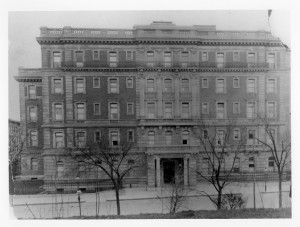May 12, 2020
This year the world marks the 200th anniversary of the birth of Florence Nightingale (1820-1910.) Her name is known around the world and nurses everywhere enjoy the fruits of her labors today. She lived a long time ago in a very different world, but she enunciated the basic philosophy of modern nursing, and introduced statistics into the study of disease.
The Aufses Archives has copies of two of Miss Nightingale’s books: Notes on Nursing and Notes on Hospitals. The Mount Sinai Hospital School of Nursing, which existed from 1881-1971, had a small collection of Nightingale letters that they had gathered over the years. Some of these were given to the Columbia University School of Nursing in 1953, as shown in the image below.

From the Aufses Archives

Hospitals, schools of nursing, archives, and history of medicine collections will be marking the 200th anniversary of Florence Nightingale this year with celebrations, blog posts, exhibits and lectures. Here are links to just a few of those celebrations going on this year:
Nightingale: Lady and Legend at the National Library of Medicine: https://circulatingnow.nlm.nih.gov/2020/05/12/nightingale-lady-and-legend/ This includes this note on sources: The National Library of Medicine’s holdings of Nightingale materials are (unsurprisingly) extensive, with over seventy printed titles and editions. In addition, the Library holds a group of Nightingale letters written between 1845 and 1878, all of which may be read as part of the Florence Nightingale Digitization Project, and a copy of an oral history interview conducted by M. Adelaide Nutting (herself a giant in the history of nursing) in 1890. A transcript is available at http://oculus.nlm.nih.gov/2935116r.
A blog post on the University of Maryland, Baltimore School of Nursing ties to Nightingale: https://www2.hshsl.umaryland.edu/hslupdates/?p=4177
A blog post at the UCLA Library about the Elmer Belt FN Collection and other Nightingaleiana we have and use: https://www.library.ucla.edu/blog/special/2020/05/11/happy-birthday-florence-nightingale
Finally, there is a special exhibit at the Florence Nightingale Museum in London called Nightingale in 200 Objects, People & Places https://www.florence-nightingale.co.uk/200objects/ Sadly, the Museum is closed due to the pandemic and is struggling financially. As they note:
Nursing, washing your hands and evidence based-healthcare, pioneered by Florence Nightingale, have become more important than ever before and we’re calling upon our friends and supporters to help us preserve her story and legacy.
Jul 21, 2016
The Mount Sinai Archives has received a large amount of new archival material over the last year, well over 186 feet of paper, photographs, and (sometimes) disintegrating leather-bound volumes. The bulk of these new collections contain material from Mount Sinai St. Luke’s Hospital and Mount Sinai West (the former Roosevelt Hospital), but they also include items documenting the Beth Israel Medical Center, Mount Sinai Queens, The Mount Sinai Hospital and the Medical School. Organizing, preserving and making available such a great quantity of material is a complex and time-consuming task, but the effort is well worth it, because these collections include many important historic treasures. Those treasures are the theme for a new Archives’ display in the Annenberg Building lobby. Here are some highlights from the display.
What makes a historical document or artifact a ‘treasure’? Sometimes, historical records provide information on an important person or an institution. The 1854 Bible belonging to the Rev. Dr. William Muhlenberg, founder of St. Luke’s Hospital, is an example of that, as are the newsletters and Annual Reports of the various Mount Sinai Health System hospitals that we have received. Other times, an item can be a ‘treasure’ because it provides context for what life was like at a specific period of time, highlighting how things have changed, or perhaps showing how some things never change. The Fathers’ Book from the Woman’s Hospital in the early 1940s does that, as do the reports created by the Mount Sinai Environmental Sciences Laboratory that are displayed. And sometimes what makes an item a ‘treasure’ is just that there is something appealing, unique or unexpected about it. Who would think that the Mount Sinai Archives has a World War II era U.S. War Department issued Japanese phrase book, currently on display in the Nursing case below the Stern Auditorium stairs? It is part of the papers sent to us by the daughter of Esther Winkler Shapiro, Class of 1944.
Perhaps the most surprising treasure we found as we put this exhibit together were the photographs and documents tucked into the back of a scrapbook from the Roosevelt Hospital School of Nursing, which was formed in 1896 and closed in 1974. This scrapbook, wrapped in the traditional blue stripe of the Roosevelt uniform, was created by Evelyn I.V. Howard, Class of 1908. The last few pages of the book include photographs and notes from Nina Gage, RN, a classmate of Miss Howard’s. These pieces document Gage’s years at a Red Cross hospital at the Hunan-Yale School for Nurses in Changsha, China from 1908-1915. There are photos of the facility as well as students and faculty members.

A view of one of the display cases showing Rev. Muhlenberg’s Bible in the far left corner and the Roosevelt nursing scrapbook in the middle.
If you are nearby, please stop in and take a look at our display. If you would like additional information, please contact us at msarchives@mssm.edu.
Apr 22, 2016
The Mount Sinai Archives has installed its latest quarterly exhibit in the lobby of the Annenberg Building. This season’s exhibit, “Hospital Trustees and the Making of New York City,” looks at the role of some of the trustees of the Mount Sinai Health System hospitals, accomplished figures who left their mark not only on their respective hospitals but on New York City as a whole.
One exhibit case contains photographs and memorabilia documenting the life and career of Charles H. Silver, who served for nearly five decades as President of the Board of Trustees at the Beth Israel Medical Center, the predecessor of today’s Mount Sinai Beth Israel. (Some of the highlights of the Mount Sinai Archives’ Silver collection have previously been featured on the blog.) The child of impoverished Lower East Side immigrants who worked his way up to wealth and influence, Silver was active in politics and philanthropy, chaired the New York City Board of Education, and was a pioneer of interfaith relations in a multicultural global city.

Pictured: The original Mount Sinai Private Pavilion, built in 1904 with an endowment from the Guggenheim family.
The second exhibit case documents the legacy of the Guggenheim family at Mount Sinai. The role of the Guggenheims in New York City philanthropy is perhaps best known in connection with the Guggenheim Museum, but members of the family also played an important role at Mount Sinai, where they served as Trustees, donors, and vocal supporters from 1889 until the end of the 20th century. Since 1904, their name has been on Mount Sinai’s largest patient care building, a symbol of their dedication to the city and people of New York.
This quarter’s Nursing History exhibit, located underneath the stairs to Stern Auditorium, documents the participation of Mount Sinai School of Nursing graduates in the Spanish-American War and the Spanish Civil War, the latter of which marks its 80th anniversary this year.
Jan 27, 2016
The Mount Sinai Archives has mounted its latest quarterly exhibit in the Annenberg elevator lobby. This season’s exhibit covers the history of the former Continuum Health Partners hospitals that are now part of the Mount Sinai Health System: Beth Israel Medical Center (now Mount Sinai Beth Israel), St. Luke’s Hospital (now Mount Sinai St. Luke’s), Roosevelt Hospital (now Mount Sinai West) and the New York Eye and Ear Infirmary (now the New York Eye and Ear Infirmary of Mount Sinai.)
 The combined histories of the former Continuum hospitals cover a significant portion of the history of medicine in New York City. The New York Eye and Ear Infirmary, founded in 1820, is the oldest specialty hospital in the United States and the oldest institution in the present Mount Sinai Health System. St. Luke’s Hospital, which opened its doors to patients in 1858, was the creation of a prominent clergyman, and Roosevelt Hospital was founded in 1868 with a bequest from a member of the distinguished New York family that later produced two U.S. Presidents. The service areas of these two hospitals, which merged in 1979, together encompass much of Manhattan’s West Side. Beth Israel, established on the Lower East Side in 1889 to provide care to impoverished Jewish immigrants, has a long tradition of community-focused medical care, including the nation’s largest nonprofit methadone treatment program.
The combined histories of the former Continuum hospitals cover a significant portion of the history of medicine in New York City. The New York Eye and Ear Infirmary, founded in 1820, is the oldest specialty hospital in the United States and the oldest institution in the present Mount Sinai Health System. St. Luke’s Hospital, which opened its doors to patients in 1858, was the creation of a prominent clergyman, and Roosevelt Hospital was founded in 1868 with a bequest from a member of the distinguished New York family that later produced two U.S. Presidents. The service areas of these two hospitals, which merged in 1979, together encompass much of Manhattan’s West Side. Beth Israel, established on the Lower East Side in 1889 to provide care to impoverished Jewish immigrants, has a long tradition of community-focused medical care, including the nation’s largest nonprofit methadone treatment program.
The exhibit will remain on display until the spring and contains numerous historic photographs and documents from the various hospitals, including an original nineteenth century minute book from the records of the Beth Israel Medical Center.
Pictured: Beth Israel Medical Center’s Linsky Pavilion as depicted in a 1964 anniversary volume.





